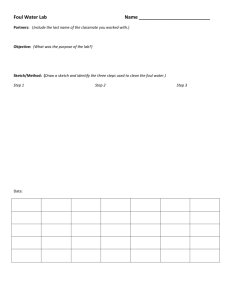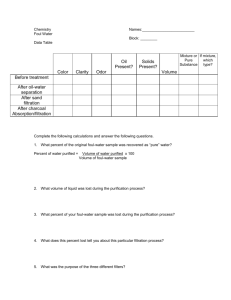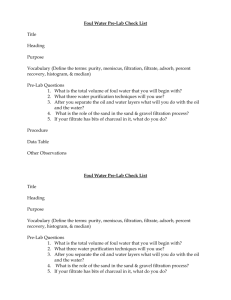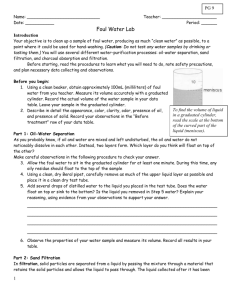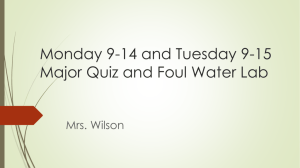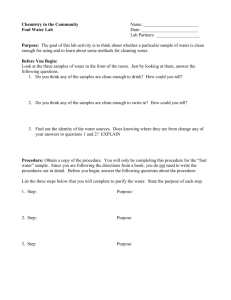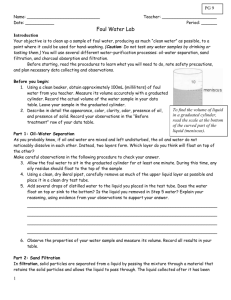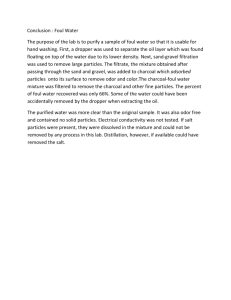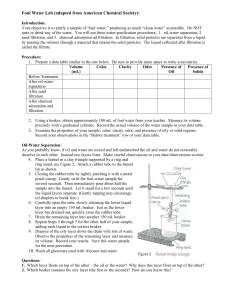Foul Water Your objective for this lab is to clean a sample of foul
advertisement
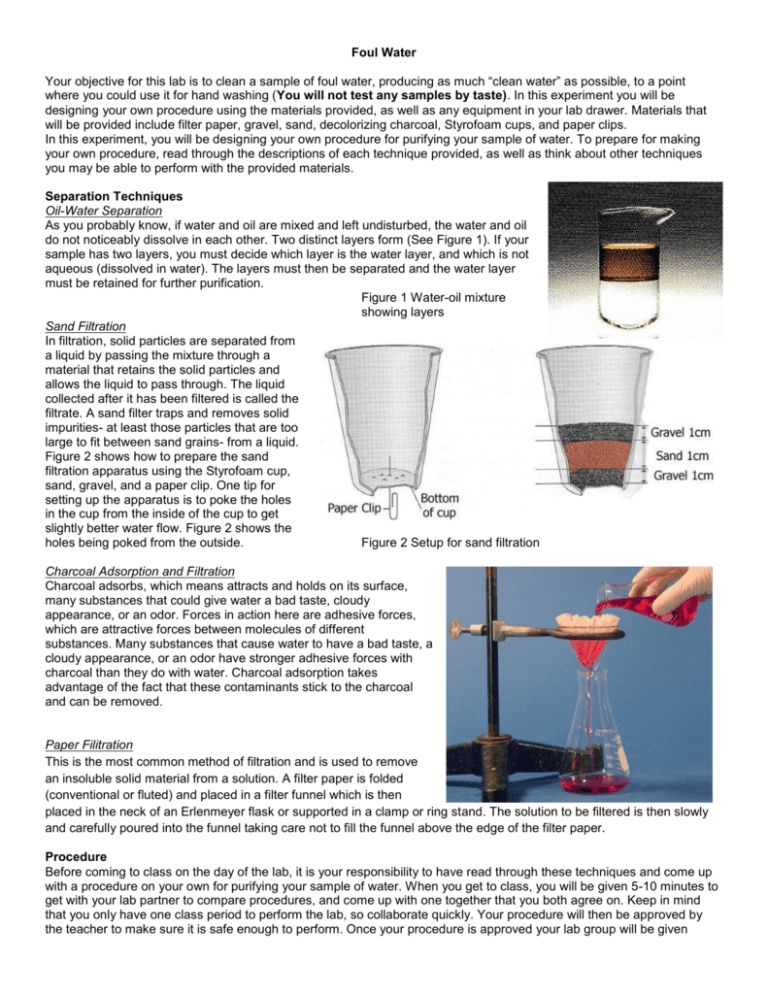
Foul Water Your objective for this lab is to clean a sample of foul water, producing as much “clean water” as possible, to a point where you could use it for hand washing (You will not test any samples by taste). In this experiment you will be designing your own procedure using the materials provided, as well as any equipment in your lab drawer. Materials that will be provided include filter paper, gravel, sand, decolorizing charcoal, Styrofoam cups, and paper clips. In this experiment, you will be designing your own procedure for purifying your sample of water. To prepare for making your own procedure, read through the descriptions of each technique provided, as well as think about other techniques you may be able to perform with the provided materials. Separation Techniques Oil-Water Separation As you probably know, if water and oil are mixed and left undisturbed, the water and oil do not noticeably dissolve in each other. Two distinct layers form (See Figure 1). If your sample has two layers, you must decide which layer is the water layer, and which is not aqueous (dissolved in water). The layers must then be separated and the water layer must be retained for further purification. Figure 1 Water-oil mixture showing layers Sand Filtration In filtration, solid particles are separated from a liquid by passing the mixture through a material that retains the solid particles and allows the liquid to pass through. The liquid collected after it has been filtered is called the filtrate. A sand filter traps and removes solid impurities- at least those particles that are too large to fit between sand grains- from a liquid. Figure 2 shows how to prepare the sand filtration apparatus using the Styrofoam cup, sand, gravel, and a paper clip. One tip for setting up the apparatus is to poke the holes in the cup from the inside of the cup to get slightly better water flow. Figure 2 shows the holes being poked from the outside. Figure 2 Setup for sand filtration Charcoal Adsorption and Filtration Charcoal adsorbs, which means attracts and holds on its surface, many substances that could give water a bad taste, cloudy appearance, or an odor. Forces in action here are adhesive forces, which are attractive forces between molecules of different substances. Many substances that cause water to have a bad taste, a cloudy appearance, or an odor have stronger adhesive forces with charcoal than they do with water. Charcoal adsorption takes advantage of the fact that these contaminants stick to the charcoal and can be removed. Paper Filitration This is the most common method of filtration and is used to remove an insoluble solid material from a solution. A filter paper is folded (conventional or fluted) and placed in a filter funnel which is then placed in the neck of an Erlenmeyer flask or supported in a clamp or ring stand. The solution to be filtered is then slowly and carefully poured into the funnel taking care not to fill the funnel above the edge of the filter paper. Procedure Before coming to class on the day of the lab, it is your responsibility to have read through these techniques and come up with a procedure on your own for purifying your sample of water. When you get to class, you will be given 5-10 minutes to get with your lab partner to compare procedures, and come up with one together that you both agree on. Keep in mind that you only have one class period to perform the lab, so collaborate quickly. Your procedure will then be approved by the teacher to make sure it is safe enough to perform. Once your procedure is approved your lab group will be given approximately 100 mL sample of foul water. You will perform your procedure, and once you believe your water is clean enough, it will be tested for conductivity with a conductivity tester. During your procedure, you will be required to find the density of your sample (Density=mass/volume) before starting, as well as after each step of the purification. In your notebook you should note the density and any numbers needed to calculate the density, as well as any and all observations, both qualitative and quantitative, you make throughout the experiment. Safety Students will wear safety goggles to protect their eyes from accidental splashes. Lab Notebook Report Format Title Purpose Safety Procedure Day 1 (Step by Step) Data for Day 1, o Qualitative Observation Results of Sample Analysis Conductivity Appearance Tyndall Effect Quantitative Observations – make sure you include the measurements needed to calculate the density of your original foul water and your “clean” sample. Density Calculations – include correct units and significant figures o Original Foul water sample o “Clean” water sample after purification o Picture of Day 1 Set-Up (You may use your phone to take a picture and then print it off and add it to the end of your lab report) Procedure Day 2 (Step by Step) Data for Day 2 o Same information at Day 1 o Picture of Day 2 Set-Up (You may use your phone to take a picture and then print it off and add it to the end of your lab report) Analysis Questions - Answer with complete sentences, you do not have to write the question. o What percent of your original foul water sample did you recover as purified water (percent recovery)? o What volume of liquid (in milliliters) did you lose in the entire purification process o What percent of your original foul water sample was lost during purification? o Were the densities different after each step? If so, what accounted for the differences? If not, why would it be the same? o How successful was each step of your procedure? o Is your water pure? How can you tell? o When taking measurements, how many decimal places did you read and record for each instrument? o Did these separation techniques cause physical or chemical changes to the sample? o How could you improve the water-purification procedures you followed so that you could recover a high percent of purified water? o Estimate the total time you spent purifying your water sample. o In your opinion, did that time investment result in a large enough sample of sufficiently purified water? Conclusion/Summary o What did you think about the lab? What did you like/dislike? Suggestions/Comments
